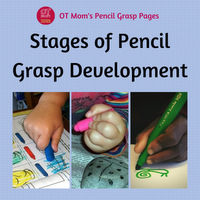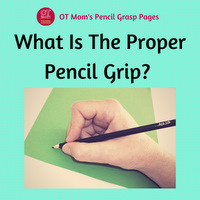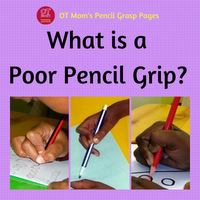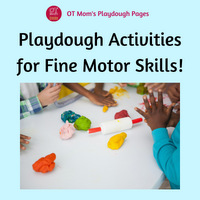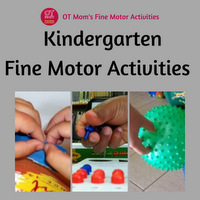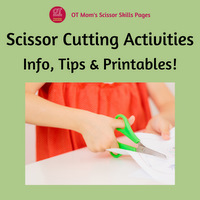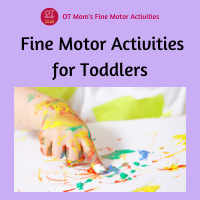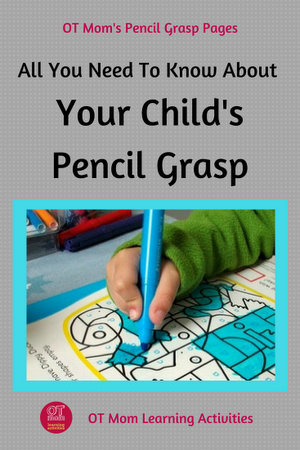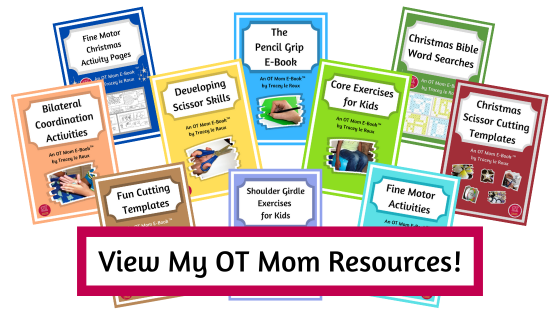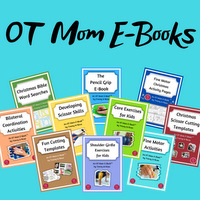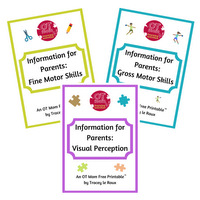- Home Page
- All About Pencil Grasp
All About Pencil Grasp:
Essential Tips & FAQ
Are you concerned about your child's pencil grasp? Perhaps a teacher has mentioned that your child holds the pencil awkwardly, or you have noticed that their hand gets tired quickly?
As an occupational therapist and homeschooling mom, I understand your concerns!
I sometimes link to products (#Ad) that are similar to those I use and love. If you do purchase something through my links, I will receive a small commission that helps support my site - thank you!
A functional grip on the pencil will enable your child to write neatly at a reasonable speed without tiring easily. But a poor pencil grip not only looks awkward but does not use the hand muscles efficiently. This can lead to fatigue and messy work.
This page contains an overview of the different questions parents often ask about pencil grasp, with links to more in-depth pages on my site.
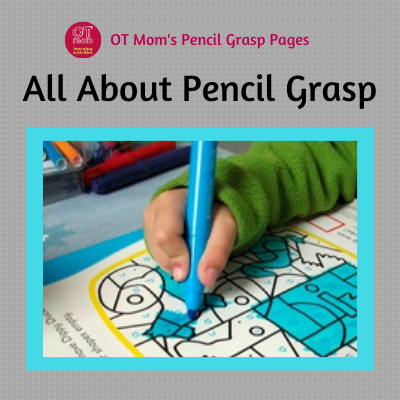
Key Takeaways For Busy Parents:
- A "weird" pencil grasp is often a symptom of other weak skills (like hand strength), not the main problem itself.
- Never force a young child into a "correct" grip they aren't developmentally ready for. This can do more harm than good.
- The best way to help your child is through play-based activities that build fine motor skills. Think playdough, using scissors, and building with small blocks!
On This Page:
- How pencil grasp develops
- What is the proper pencil grip?
- What is a poor pencil grip?
- How can I help my child develop a good pencil grip?
- When should I consider an OT assessment?
- Other Questions Parents Ask
- Pencil Grip Information Resource
- References and Resources
How Pencil Grasp Develops
Just as you would not expect your toddler to run and skip like your 6-year-old, we shouldn't expect your toddler to hold a pencil like a 6-year-old either. A child's pencil grip usually matures naturally, as their shoulder, arm and hand muscles get stronger and more coordinated.
But if we force the "correct grip" before the muscles are developmentally ready, we run the risk of awkward pencil grasps emerging as the child compensates for a lack of strength and control.
A brief overview of pencil grasp development:
- Age 1 - 2: holds the crayon in a fist, uses the whole arm to make marks
- Age 2 - 3: holds the crayon across the palm with the fingers pointing down to the paper
- Age 3- 4: Holds the pencil with 4 or 5 fingers
- Age 4 - 6: Holds the pencil with 3 or 4 fingers, starts to move the fingers to control the crayon
Understanding these stages is really important! To see photos and get more information and tips, read my page about the developmental stages of pencil grasp.
I have written an article to answer questions parents have asked about the right age to hold a pencil to write - you may find it helpful!
What Is The Proper Pencil Grip?
A "proper" or "correct" pencil grip is one that allows a child to use the small muscles of the hands and fingers to move the pencil. This enables them to form letters neatly and efficiently.
Traditionally, the three-finger "dynamic tripod" grasp was considered to be the correct grasp, but other grasps can also be functional, if they allow refined finger movements and the child can write neatly without getting tired.
Studies have shown that being able to use the small muscles of the hand and fingers plays a big role in a child’s handwriting, so it makes sense that a proper pencil grip should allow those refined finger movements.
Visit my page to view the different functional, "proper" grasps that kids can use.
And find out why holding the pencil between the index and middle fingers (aka the Monk's grasp that Taylor Swift uses!) is also functional!
 An Adaptive Grip For Kids and Adults
An Adaptive Grip For Kids and AdultsWhat Is A Poor Pencil Grip?
A poor pencil grip is one that is inefficient. In other words, it blocks finger movements, and causes unnecessary fatigue, discomfort and messy work.
A poor grip is on the pencil is often a red flag, but it is rarely the only cause of poor handwriting. It is often a child's way of compensating for other weak areas.
A good occupational therapist will assess all the factors affecting your child's handwriting, not just the way your child holds the pencil!
Check out my page of Poor Pencil Grips for more information and photos to help you identify what grips are not functional.
A poor pencil grip together with messy handwriting can also be a symptom of dyslexia. This link goes to an article on the Dyslexia website.
How Can I Help My Child?
If your child's grasp is inefficient, it can impact their pencil control and therefore their handwriting.
If you notice this, simply telling your child to "hold the pencil better" is not going to help. The poor grasp is a symptom, and you need to address the cause!
And, contrary to popular opinion, pencil-and-paper activities are NOT the best way to help your child develop a good pencil grasp!
Instead of fixing the pencil grip itself, focus on helping your child develop the underlying skills. Take a look at the important foundation skills, then try some of the many play-based activities on my website to develop scissor skills, hand strength and finger dexterity!
If your child is younger, check out my fun toddler activities and ways to build fine motor skills with playdough!
When To Consider An OT Assessment
If your child has a weird-looking grip but their handwriting is neat and they aren't getting tired or sore or avoiding writing tasks, then you could simply keep an eye on it. Check if they are keeping up with increased writing demands as they get older.
If you are concerned about your child's grasp or handwriting, an occupational therapy assessment is the best way to identify the specific underlying causes.
Consider seeking an OT evaluation if any of these are true for your child:
- Complains of a sore or tired hand when writing or coloring.
- Has very messy, slow, or illegible handwriting compared to their peers.
- Actively avoids tasks like drawing, coloring, or using scissors.
- Uses a very awkward grasp that causes them to move their hand or arm to write (instead of using finger movements to control the pencil if they are older than 7 years)
- Not keeping up with written work required of them in class
An OT can evaluate where your child needs support and help with targeted interventions and recommendations.
Other Questions Parents Ask
Click on the questions to read the answers to common questions parents have asked about pencil grasps!
Should We Use Pencil Grippers
for Kids?
Should We Use Pencil Grippers
for Kids?
Teachers and parents often ask me about using commercial pencil grippers for kids.
My honest answer? Issuing a pencil grip without addressing the underlying fine motor issues is like putting a sticky plaster on a festering wound. It might cover the problem, but it doesn't heal it.
I've seen so many children contort their fingers around the pencil gripper itself! They simply adapt their poor pencil grip to the new shape.
However, that doesn't mean I avoid using pencil grippers. They can be a helpful tool if they are used as part of a larger plan to build hand strength.
If your child is doing hand-strengthening activities and a specific grip helps them control the pencil better, then it can be a useful aid. Sometimes, simply switching to a thick triangular pencil can make a world of difference without needing a separate grip.
But you can check out my reviews of different pencil grippers if you think this may help your child.
Problem: My Child Has a Weak Pencil Grasp and
Can't Press Hard Enough
Problem: My Child Has a Weak Pencil Grasp and Can't Press Hard Enough
A mom once told me she felt like it was "cheating" to let her son use a marker instead of a pencil - he had a weak pencil grip owing to fine motor difficulties.
Let me be clear: it is absolutely not cheating! If using a tool like a thick marker allows your child to form letters and feel a sense of accomplishment, it's a wonderful strategy. It boosts morale and allows them to focus on the task of learning to write, not the struggle of making legible marks.
How to Help Kids With "Weak" Pencil Grips
- Build Hand Strength: The long-term solution is to build hand strength. Squeezing playdough, playing with water squeeze toys in the bath, and using a spray bottle to water plants are all fun ways to do this. Check out my easy hand strengthening exercises you can do at home!
- Encourage Pressure: Give your child activities where they have to press hard. Crayon rubbings are perfect for this. Place a leaf, a coin, or a rubbing plate under a piece of paper and have them rub over it with the side of a crayon to make the image appear.
- Use Other Ways To Write: if your child needs to master letter formations, spelling or any other "practice" work, then try these fun ways to practice writing without a pencil - this helps kids focus on the technique and not on controlling a pencil
If your child still struggles even after trying these suggestions, please consult your health professional!
Problem: My Older Child's
Grip Has Reverted to a Toddler Grasp
Problem: My Older Child's
Grip Has Reverted to a Toddler Grasp
A parent once told me her almost 9-year-old had reverted to holding her pencil in a fist, especially when starting cursive.
When this happens, some detective work is needed! An older child reverting to an immature grasp is usually a sign that something is amiss. Here are some questions I would ask:
- Is it fatigue? Are their hand muscles tiring out from the demands of writing?
- Is it stress? Is the pressure of a new task, like learning cursive, causing them to tense up and revert to what feels "strongest"?
- Are there emotional factors? Is a younger sibling getting attention for their cute, fisted grasp?
How to Help:
- Go Back to Basics: Start every writing session with a few minutes of hand-strengthening exercises. Try these fine motor ideas for older kids
- Change the Tool: Try going back to a thicker, triangular pencil. Even older kids find them more comfortable and less fatiguing. You can also try a large pencil gripper like The pencil grip to reduce hand fatigue.
- Try an Alternative Grip: For children who struggle with fatigue, many have found success with the adapted tripod grasp (also called the "Monk's Grasp"). This is where the pencil is held between the index and middle fingers. It's much less tiring for many people and can be a fantastic functional alternative.
If you've tried these strategies and are still concerned about your child's poor pencil grip, please seek an occupational therapy evaluation.
Should I Correct My Child's Weird Pencil Grasp?
Should I Correct My Child's Weird Pencil Grasp?
We want all our kids to have a functional pencil grip which will allow hand and finger muscles to move freely (although some grips are better at this than others).
But just telling your child to “hold the pencil better” is NOT going to help! We need to address some of the reasons your child has a poor grip in the first place!
Here are some strategies to try:
- To counteract fatigue, help your child to work on hand and finger strength and dexterity.
- If you have been working on hand and finger strength, you can then try out a variety of pencils and pencil grippers to try and increase your child's comfort while writing.
- I also recommend an occupational therapy assessment to help figure out WHY your child is holding the pencil so badly, and then you and the OT can make a plan to work on the skills that are missing.
If your child has a weird pencil grip, but currently seems to be keeping up with classwork, and has neat handwriting, then my recommendation is that you keep a careful eye out for hand fatigue and deteriorating work (especially as the writing load increases)
My Own Pencil Grip Is Terrible, And I Coped Fine. Does My Child Really Need Help?
My Own Pencil Grip Is Terrible, And I Coped Fine. Does My Child Really Need Help?
This is such an understandable question. Many adults today have an awkward or inefficient pencil grip and feel they are doing just fine! So, it's natural to wonder if a poor pencil grip is truly a problem that needs fixing with expensive occupational therapy!
The answer is: it depends. The goal is not a "perfect" grip, but a **functional pencil grip**. If a child's grip, no matter how it looks, allows them to write without pain, fatigue, or falling behind, then it *may* not be an issue.
*However*, an inefficient grip that was manageable 20 years ago might cause significant problems for a child in today's pressured classroom.
Here are the long-term effects we often see when a truly problematic pencil grip isn't addressed:
- Pain and Fatigue: To make up for weak finger muscles, a child might tense their neck and shoulder muscles or use their whole wrist to write. In the long run, these compensations can result in a sore neck, a tired hand, and an aversion to writing.
- Slow Handwriting Speed: An inefficient grip can make it very difficult to keep up. This becomes a major issue when needing to take notes quickly, and finish essays and exams in a limited time.
- Illegible Work: When a child is struggling just to hold the pencil, legibility often suffers. Some teachers may not have the time to decipher messy writing, which can unfortunately lead to lower marks than a child deserves.
So, how do you know if your child's grip is a real problem?
- Further up my page, I have a checklist of when to consider seeing an OT.
- Chat to your child's teachers - they have a good sense of who is coping and who is struggling.
An occupational therapy assessment doesn't always lead to expensive, long-term therapy. Sometimes, the OT will simply provide you with a targeted home program of fine motor activities or even just reassure you if your child's grip is functional.
However, if your child genuinely needs support, the OT will be able to guide and provide long-term workarounds like scribes and keyboarding assistance when needed.
Investing a little time now to build your child's skills and confidence can prevent significant struggles and frustration later on.
My Complete Pencil Grip Information Resource!
This printable resource answers some common questions that teachers and parents have about pencil grasp.
It explores functional and dysfunctional grips, the developmental stages of holding a pencil, and includes lots of photos as well as a helpful pencil grasp checklist!
Thanks for visiting! I hope you were helped! If you were, then please share this page to help others!
Why not sign up for my newsletter to keep in touch with new pages and activities on my site?
- Home Page
- All About Pencil Grasp
Share this page to help others!
References And Resources
1. Koziatek, S. ; Powell, N.J. Pencil Grips, Legibility, and Speed of Fourth-Graders' Writing in Cursive AJOT 57(3):284-8 May 2003
DOI: 10.5014/ajot.57.3.284
2. Schwellnus, H.; Carnahan, H. ; Kushki, A. ; Chau, T. Writing Forces Associated With Four Pencil Grasp Patterns in Grade 4 Children AJOT March 2013
DOI: 10.5014/ajot.2013.005538
3. Selin, A-S. Pencil Grip: A Descriptive Model And 4 Empirical Studies (dissertation). Abo Akademi University Press, 2003.
ISBN 951-765-130-9 ISBN 951-765-130-9
4. Ziviani, J. ; Elkins, J. Effect of Pencil Grip on Handwriting Speed and Legibility. Educational Review 38(3):247-257 • November 1986
DOI: 10.1080/0013191860380305
Didn't find what you were looking for? Try a search of my site!
